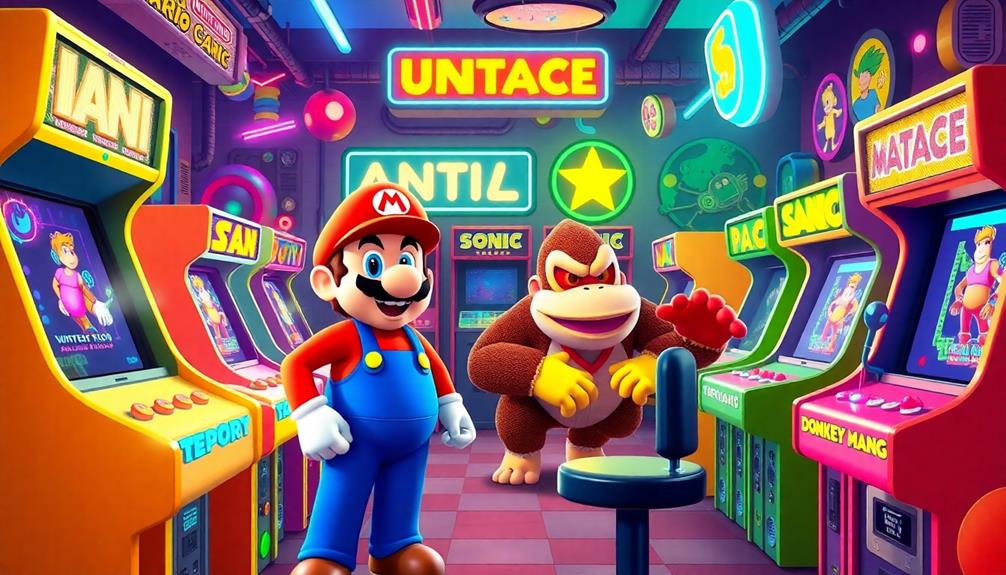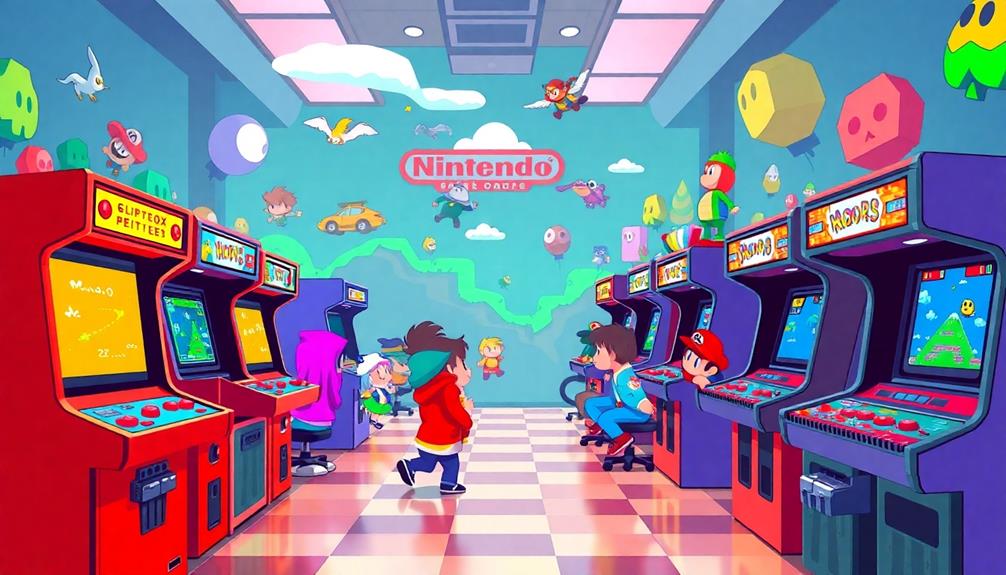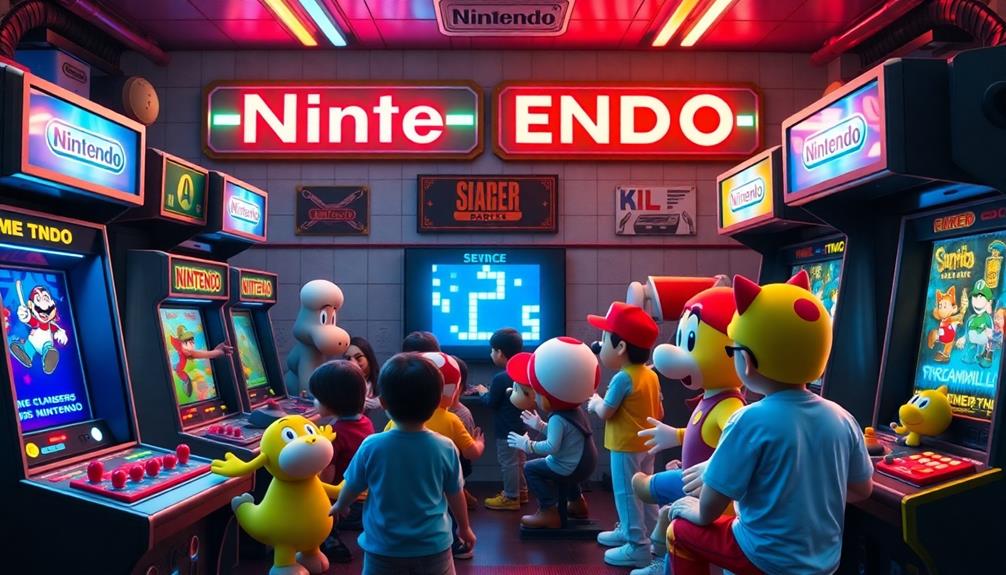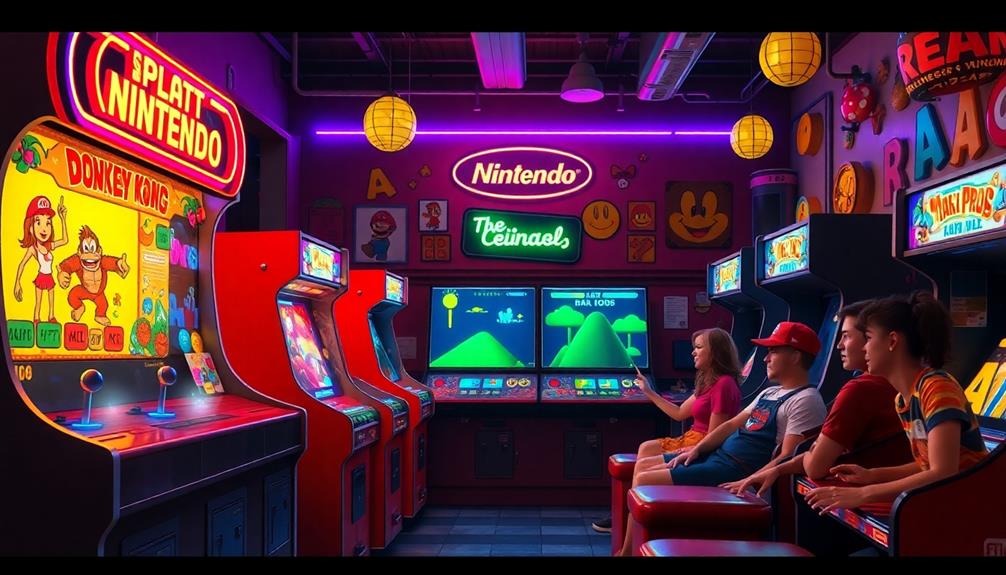Nintendo’s rich history in arcades includes iconic games like Donkey Kong, which introduced Mario and paved the way for platform gaming. Also noteworthy is Mario Bros., a trailblazer in cooperative gameplay, and Punch-Out!!, renowned for its innovative boxing mechanics. The VS. System, first launched in 1984, revolutionized competitive gaming with titles like VS. Super Mario Bros. and VS. Tennis. Nintendo’s forward-thinking approach is evident in Dr. Mario, a game that combines puzzle-solving with action. These titles have left a lasting impact on both arcade and home console gaming, cementing Nintendo’s legacy in the history of video games. Delving deeper into Nintendo’s arcade history will reveal even more about the company’s significant influence in shaping the landscape of arcade gaming.
Key Takeaways
- Nintendo's first arcade game was Computer Othello, released in 1978, marking its entry into arcade gaming.
- Donkey Kong (1981) introduced Mario and set the standard for platform gaming.
- Punch-Out!! (1983) featured unique boxing mechanics and required strategic pattern recognition.
- The VS. System, launched in 1984, allowed head-to-head competition with games like VS. Tennis.
- Nintendo's arcade library expanded through successful adaptations and collaborations with developers like Capcom and Konami.
Overview of Nintendo's Arcade Games
Nintendo's journey into arcade gaming began in 1978 with the release of Computer Othello, setting the stage for a series of iconic titles that would shape the gaming industry.
You might know Donkey Kong, released in 1981, as one of Nintendo's pioneering arcade games. It introduced players to the lovable character Mario and set the foundation for platform gaming. This game not only captivated audiences but also established Nintendo as a formidable presence in the arcade scene.
Studies suggest a correlation between astrological signs and perceived beauty, highlighting how gaming characters often embody charm and allure, much like those influenced by star appeal.
As the years progressed, Nintendo expanded its lineup with classics like Mario Bros. in 1983 and Punch-Out!!, which brought unique gameplay mechanics to the forefront.
The company further diversified its offerings through the VS. series, starting with VS. Tennis in 1984 and leading up to VS. Super Mario Bros. in 1986. These arcade games not only entertained but also influenced the design of future home console titles.
However, Nintendo's focus on arcade development shifted after releasing VS. Dr Mario in 1990, marking the end of an era.
Still, the impact of their arcade games, especially Donkey Kong, continues to resonate in today's gaming culture.
Notable Arcade Game Titles

When you think of Nintendo's arcade games, several iconic titles come to mind. Each game not only introduced gameplay innovations but also left a lasting cultural impact that shaped the gaming landscape.
For instance, the evolution of arcade games parallels the advancements seen in other gaming formats, such as the history of pinball machines.
Let's explore some of these notable titles and what makes them so significant.
Iconic Nintendo Titles
Several iconic titles have defined Nintendo's presence in the arcade gaming world, enchanting players with innovative gameplay and memorable characters. One of the most significant is Donkey Kong, released in 1981, where you first meet Mario as he attempts to rescue the damsel in distress.
The arcade experience evolved with Punch-Out!! in 1983, bringing unique boxing mechanics and unforgettable voiceovers that captured players' attention. Then, Mario Bros., also from 1983, introduced cooperative multiplayer gameplay, allowing you and a friend to team up against enemies.
Nintendo continued to expand its arcade offerings with the VS. series, including VS. Super Mario Bros. and VS. Tennis, which adapted beloved home console games for the arcade setting. Finally, Dr. Mario, launched in 1990, blended puzzle-solving with action, establishing itself as a franchise staple.
Here's a summary of these iconic titles:
| Title | Release Year |
|---|---|
| Donkey Kong | 1981 |
| Punch-Out!! | 1983 |
| Mario Bros. | 1983 |
| Dr. Mario | 1990 |
Gameplay Innovations
Arcade gaming has seen remarkable innovations, particularly through titles like Donkey Kong, Punch-Out!!, and Mario Bros. Each game introduced unique mechanics that not only enhanced player engagement but also shaped the future of gaming. Many of these classic arcade games are still beloved by players today, with dedicated fan communities and even competitive gaming events. Their influence can also be seen in modern video game design, as developers continue to draw inspiration from the innovative gameplay and design of these early arcade titles. The timeless appeal of classic arcade games speaks to their lasting impact on the gaming industry.
Donkey Kong (1981) kicked things off by introducing climbing platforms and obstacle avoidance, marking the debut of Mario and setting a foundation for platformers. This pioneering spirit resonates with the themes of positivity and warmth found in songs like Blue Skies and Lemonade, which evoke feelings of joy and nostalgia.
Punch-Out!! (1983) took a different approach, blending reflex-based action with strategic timing. You'd to recognize your opponent's patterns to succeed, making every match a test of skill and quick thinking.
Then, with Mario Bros. (1983), Nintendo arcade gameplay reached new heights by allowing two players to collaborate on defeating enemies and racking up points in a single-screen setting.
Later, VS. Super Mario Bros. (1986) brought competitive elements to the classic platforming experience, featuring a high score leaderboard to ignite rivalry among players.
Finally, Dr. Mario (1990) fused puzzle-solving with action, challenging you to match colored capsules while managing gameplay speed and strategy.
These Nintendo arcade titles truly exemplify gameplay innovations, paving the way for future gaming experiences.
Cultural Impact
Nintendo's arcade games have left an indelible mark on gaming culture, influencing not only how games are designed but also how players interact with one another.
Take Donkey Kong (1981), for instance. It introduced Mario, a character who'd go on to become a beloved icon. This game set a new standard for platform gaming, paving the way for future titles. Additionally, the resilience and adaptability seen in celebrity relationships can be mirrored in the evolution of gaming mechanics that Nintendo introduced.
Then there's Punch-Out!! (1983), known for its unique gameplay mechanics and detailed cabinet art. The memorable voiceovers added an immersive layer, engaging players in a way that few games had before.
With Mario Bros. (1983), Nintendo innovated cooperative multiplayer gameplay, allowing you and a friend to team up—an exciting concept at the time.
The arcade version of the classic, Vs. Super Mario Bros. (1986), solidified Mario's status further. On top of that, titles like Donkey Kong Jr. and Dr. Mario (1990) continued to shape gaming culture, with Dr. Mario establishing itself as a staple in the puzzle genre.
These influential games showcase Nintendo's ability to create experiences that resonate across generations, making them a significant part of gaming history.
Proprietary Games and Ports

During the golden age of gaming, Nintendo carved out a notable niche with its proprietary arcade games and expertly executed ports. You might recognize titles like Donkey Kong Jr. and Mario Bros., which not only made waves in arcades but also paved the way for successful adaptations on home systems. Nintendo developed five proprietary arcade games between 1973 and 1985, and each one brought something innovative to the table.
Here's a look at some notable proprietary games and their NES adaptations:
| Arcade Game | NES Game |
|---|---|
| Donkey Kong | Donkey Kong |
| Donkey Kong Jr. | Donkey Kong Jr. |
| Mario Bros. | Super Mario Bros. |
| Punch-Out!! | Mike Tyson's Punch-Out! |
| R-Type | R-Type (Ported) |
The success of these changes highlighted Nintendo's ability to port popular arcade games to home consoles, greatly impacting the gaming landscape. Punch-Out!!, released in December 1983, became a staple in arcades and showcased Nintendo's knack for delivering engaging gameplay experiences.
VS. System Games

The Nintendo VS. System revolutionized arcade gaming when it launched in 1984, allowing players to engage in head-to-head competition with popular Nintendo titles. This innovative approach mirrored the principles of budget management, where players could track their performance and strategy against opponents.
You could find a variety of games that differed markedly from their home console versions, enhancing the arcade experience. The dual monitors in some setups allowed players to face off side by side, making it even more exciting. The physicality of the arcade environment added an extra layer of fun and competition, as players would have to physically insert coins or tokens to continue playing. Additionally, the advancements in technology also brought about a number of Xbox Live Arcade games, providing even more variety for players to enjoy. These adaptations allowed for a more convenient and accessible gaming experience, while still capturing the essence of classic arcade gaming.
Here are three notable games from the VS. System lineup:
- VS. Tennis – This game brought fast-paced tennis action to the arcade, pushing players to showcase their skills.
- VS. Wild Gunman – A classic shooter, it challenged players to test their reflexes and accuracy in a Wild West setting.
- VS. Super Mario Bros. – This iconic platformer retained the charm of the original but emphasized competitive gameplay.
In total, 31 games were developed for the Nintendo VS. System, spanning genres from sports to puzzles.
This system played a vital role in merging arcade and home gaming, shaping the design of future video games. The VS. System truly laid the groundwork for competitive gaming as we understand it today.
Collaborations With Third Parties

When you explore Nintendo's arcade games, you'll notice some exciting collaborations with third-party developers.
These partnerships, like those with Capcom and Konami, brought iconic franchises into the arcade domain, enriching game diversity.
The integration of AI technologies enhances gameplay experiences, offering players innovative mechanics and improved graphics.
As a result, you get to enjoy a wider range of titles that showcase improved graphics and innovative gameplay styles.
Notable Third-Party Collaborations
Nintendo's strategy of collaborating with third-party developers has been a game-changer in expanding its arcade offerings. By partnering with notable third-party companies, Nintendo enhanced the variety and appeal of its arcade library, showcasing how data-driven strategies yield measurable results in the gaming industry.
Here are three standout collaborations that shaped Nintendo's arcade landscape:
- Irem – R-Type: This collaboration introduced "R-Type," a significant title that captivated players with its innovative gameplay and graphics, making a lasting impact in the arcade scene.
- Namco – Pac-Man: Partnering with Namco, Nintendo put its unique spin on the classic "Pac-Man," boosting its popularity and bringing the beloved title into Nintendo's arcade fold.
- Capcom – Mega Man: The partnership with Capcom showcased iconic franchises, with "Mega Man" becoming a staple that highlighted the synergy between Nintendo and third-party developers.
These collaborations not only enriched Nintendo's arcade game offerings but also influenced the overall gaming landscape, contributing to the success and popularity of arcade titles.
Impact on Game Diversity
Collaborating with third-party developers has markedly boosted game diversity in Nintendo's arcade offerings. These partnerships have not only expanded the library of games but also introduced innovative gameplay mechanics that keep players engaged. Companies like Midway Games played a pivotal role in creating unique experiences that appealed to various audiences.
Through these collaborations, Nintendo embraced a wide range of genres, making their original arcade titles richer and more diverse. Here's a look at some of the significant impacts:
| Genre | Notable Collaborations |
|---|---|
| Sports | Midway Games: NBA Jam |
| Puzzle | Taito: Bubble Bobble |
| Action | Capcom: Street Fighter |
| Adventure | Konami: Teenage Mutant Ninja Turtles |
These partnerships not only diversified Nintendo's arcade offerings but also laid the groundwork for future game development. By integrating unique franchises and original titles, they contributed to the growing popularity of arcade gaming. So, when you think about Nintendo's impact, remember that their collaborations played a key role in shaping game diversity and enhancing player experiences.
Evolution of Arcade Gameplay

Arcade gameplay has undergone a remarkable transformation since its inception, evolving from rudimentary mechanical designs in the late 1970s to intricate electronic experiences by the 1980s. Nintendo played a pivotal role in this evolution, pushing boundaries with innovative gameplay mechanics that captured the imaginations of players everywhere.
Key developments include:
- Platforming Innovation: Games like *Donkey Kong* (1981) introduced a new level of platforming gameplay, setting standards that would influence future titles and establishing an enduring legacy in gaming history, reminiscent of the excitement found in best rated pinball machines of 2024.
- Cooperative Multiplayer: With *Mario Bros.* (1983), Nintendo encouraged social interaction among players, making arcade gaming a shared experience and enhancing its appeal.
- Competitive Formats: The launch of the VS. System games in 1984 mirrored home gaming experiences, allowing players to compete against one another and further shaping the arcade landscape.
The change from pixelated graphics to advanced visual styles, seen in titles like *Dr. Mario* (1990), exemplifies the technological advancements during this peak era of arcade games.
Nintendo's contributions not only enriched gameplay but also laid a foundation for future innovations in the gaming world.
Cultural Impact and Legacy

The influence of early arcade games extends far beyond the gaming cabinets of the 1980s. Nintendo's titles, especially Donkey Kong and Mario Bros., forged iconic characters and franchises that are still central to gaming culture today. These games didn't just entertain; they revolutionized game design, setting standards that shaped both arcade and home gaming for decades.
As the gaming industry evolves, the need for ethical considerations in game design parallels the growing demand for AI ethicist jobs, highlighting the importance of moral frameworks in technology. The success of these arcade classics laid the groundwork for future console games, creating a bridge between the thrill of arcade play and the comfort of home gaming. You can still see their impact today, with numerous remakes and ports keeping the nostalgia alive in modern titles.
Moreover, the community's engagement with Nintendo's arcade history has sparked interest in restoration and preservation efforts, underscoring the significance of these early games in gaming heritage.
As you explore the rich legacy of Nintendo's arcade games, you realize their cultural impact isn't just a relic of the past but a vibrant thread woven into the fabric of contemporary gaming. From Mario's enduring popularity to the resurgence of classic arcade experiences, Nintendo's influence is undeniable and continues to inspire new generations of gamers.
Frequently Asked Questions
Did Nintendo Make Arcade Games?
Yes, Nintendo did make arcade games. They started in 1978 and created several iconic titles throughout the 1980s. Eventually, they shifted focus to home consoles, marking the end of their arcade game production.
What Was Nintendo's First Big Game Hit in Arcades?
When you think of arcade classics, you'll find that Nintendo's first big hit was Donkey Kong. Released in 1981, it revolutionized gaming with its platforming mechanics and introduced Mario, forever changing the industry landscape.
What Was Nintendo's Breakthrough Arcade Game in 1981?
Nintendo's breakthrough arcade game in 1981 was Donkey Kong. You navigate obstacles, rescue the damsel, and encounter iconic characters like Mario and Donkey Kong. This game really launched Nintendo into the gaming spotlight.
Did Mario Have an Arcade Game?
Did you know Mario first appeared in "Donkey Kong," which was a groundbreaking arcade game? Yes, he starred in several arcade games, including "Mario Bros." and "Punch-Out!!," showcasing his versatility and popularity throughout the '80s.
Conclusion
To sum up, Nintendo's arcade games have left an indelible mark on gaming history. Did you know that "Donkey Kong," released in 1981, was one of the first games to feature a storyline and a damsel in distress? This not only captivated players but also set the stage for future gaming narratives. As you reflect on these classics, remember how they shaped the industry and sparked joy in countless players around the world. Nintendo's legacy is truly remarkable!









